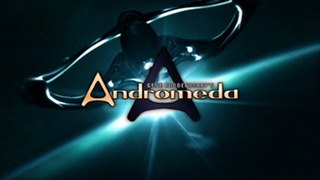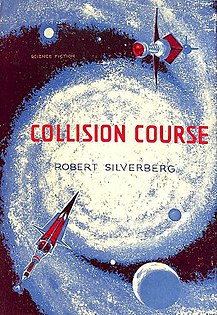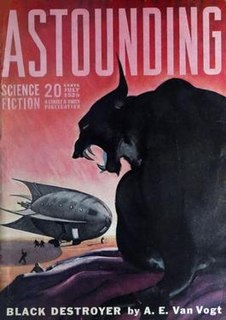
Alfred Elton van Vogt was a Canadian-born science fiction author. His fragmented, bizarre narrative style influenced later science fiction writers, notably Philip K. Dick. He was one of the most popular and influential practitioners of science fiction in the mid-twentieth century, the genre's so-called Golden Age, and one of the most complex.The Science Fiction Writers of America named him their 14th Grand Master in 1995.

Triangulum is a small constellation in the northern sky. Its name is Latin for "triangle", derived from its three brightest stars, which form a long and narrow triangle. Known to the ancient Babylonians and Greeks, Triangulum was one of the 48 constellations listed by the 2nd century astronomer Ptolemy. The celestial cartographers Johann Bayer and John Flamsteed catalogued the constellation's stars, giving six of them Bayer designations.

Andromeda is a Canadian-American science fiction television series, based on unused material by Gene Roddenberry, developed by Robert Hewitt Wolfe, and produced by Roddenberry's widow, Majel Barrett. It starred Kevin Sorbo as High Guard Captain Dylan Hunt. The series premiered on October 2, 2000, and ended on May 13, 2005.

The Andromeda Galaxy, also known as Messier 31, M31, or NGC 224 and originally the Andromeda Nebula, is a barred spiral galaxy approximately 2.5 million light-years from Earth and the nearest major galaxy to the Milky Way. The galaxy's name stems from the area of Earth's sky in which it appears, the constellation of Andromeda, which itself is named after the Ethiopian princess who was the wife of Perseus in Greek mythology.

Orphans of the Sky is a science fiction novel by American writer Robert A. Heinlein, consisting of two parts: "Universe" and its sequel, "Common Sense". The two novellas were first published together in book form in 1963. "Universe" was also published separately in 1951 as a 10¢ Dell paperback. The work presents one of the earliest fictional depictions of a generation ship.

The Triangulum Galaxy is a spiral galaxy 2.73 million light-years (ly) from Earth in the constellation Triangulum. It is catalogued as Messier 33 or NGC 598. The Triangulum Galaxy is the third-largest member of the Local Group of galaxies, behind the Milky Way and the Andromeda Galaxy. It is one of the most distant permanent objects that can be viewed with the naked eye.
"Blind Alley" is a science fiction short story by American writer Isaac Asimov. It was first published in the March 1945 issue of Astounding Science Fiction, and later included in the collection The Early Asimov (1972).

The Voyage of the Space Beagle (1950) is a science fiction novel by Canadian-American writer A. E. van Vogt. An example of space opera subgenre, the novel is a "fix-up" compilation of four previously published stories:

The Godmakers (1972) is a science fiction novel by Frank Herbert. The title of early editions was sometimes styled The God Makers.
Coeurl is a fictional alien race of predators created by science fiction novelist A. E. van Vogt (1912–2000) and featured in his first published short story "Black Destroyer" (1939), later incorporated in the novel The Voyage of the Space Beagle (1950). The species' appearance is comparable to a large cat, except in that its forelegs are twice as long as its hind legs, and it possesses tentacles attached to its shoulders that terminate in suction cups. Its skin coloration is not mentioned, but was depicted as black in the cover art for its original magazine appearance. It sustains itself by feeding upon a substance it calls the Id of other beings.

Robert Abernathy (1924–1990) was an American science fiction author during the 1940s and 1950s. He was known primarily for his short stories which were published in many of the pulp magazines that flourished during the Golden Age of Science Fiction. Many of his stories have been included in anthologies of classic science fiction such as the French Les Vingt Meilleurs Récits de science-fiction edited by Hubert Juin.
Galaxies other than the Milky Way are popular settings for creators of science fiction, particularly those working with broad-scale space opera settings. Among the most common settings are the Andromeda Galaxy, the Magellanic Clouds, and the Triangulum Galaxy, all part of the Local Group close to the Milky Way, and in the cases of Andromeda and Triangulum the Local Group's two largest other galaxies. The difficulties involved in crossing the immense distances between galaxies are often overlooked in this type of science fiction.
Nebulae, often being visually interesting astronomical objects, are frequently used as settings or backdrops for works of science fiction.

The study of black holes, gravitational sources so massive that even light cannot escape from them, goes back to the late 18th century. Major advances in understanding were made throughout the first half of the 20th century, with contributions from many prominent mathematical physicists, though the term black hole was only coined in 1967. With the development of general relativity other properties related to these entities came to be understood, and their features have been included in many notable works of fiction.

Eye (1985) is a collection of 13 science fiction short stories by American writer Frank Herbert. All of the works had been previously published in magazine or book form, except for "The Road to Dune".

House of Suns is a 2008 science fiction novel by Welsh author Alastair Reynolds. Reynolds announced the title on 7 June 2007, when he was about halfway through writing it.

Collision Course is a science fiction novel by American author Robert Silverberg, first published in hardcover in 1961 by Avalon Books and reprinted in paperback as an Ace Double later that year. Ace reissued it as a stand-alone volume in 1977 and 1982; a Tor paperback appeared in 1988. An Italian translation was also published in 1961, and a German translation later appeared. Silverberg planned the novel as a serial for Astounding Science Fiction, but John W. Campbell rejected the work and Silverberg eventually sold a shorter version to Amazing Stories, where it appeared in 1959.
This is a list of works by the science fiction author Frank Herbert.

Men, Martians and Machines is a collection of science fiction short stories by the British writer Eric Frank Russell. It was first published in 1955.

"Black Destroyer" is a science fiction short story by Canadian-American writer A. E. van Vogt, first published in Astounding SF in July 1939. It has been marked as the story that represents the start of the Golden Age of Science Fiction.















